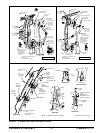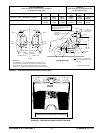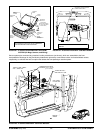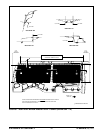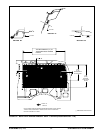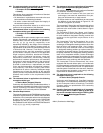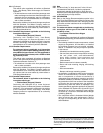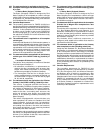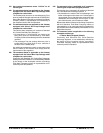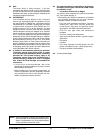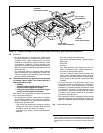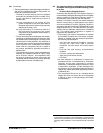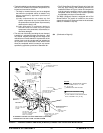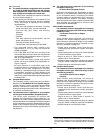
E-SERIES (May, 2004)38
E-SERIES (May, 2004) 39
STATEMENTS OF CONFORMITY
210.1 (Continued)
This vehicle, when completed, will conform to Standard
210.1, User-Ready Tether Anchorages for Restraint
Systems, if:
• No alternations are made to the front passenger seat
tether anchorages and access to the anchorages is not
restricted; the front passenger seat, its anchorages,
the oor pan and its reinforcements are not altered;
and no seats are added.
Because the addition of seats would change compliance
with this Standard, Ford Motor Company makes no
representations as to conformity with this Standard for
any vehicle that has seats added by Intermediate or
Final Stage Manufacturers.
210.1 Canadian Requirements applicable to the following
incomplete vehicle type:
• E-Series Basic (Stripped) Chassis
Conformity with Standard 210.1, User-Ready
Tether Anchorages for Restraint Systems, is not
substantially affected by the design of these incomplete
vehicles; accordingly, Ford Motor Company makes no
representations as to conformity with this Standard.
210.2 Canadian Requirements:
The statement below is applicable to all incomplete
vehicle types if the GVWR is 3856 kg [8,500 lb] or less,
except Basic Stripped Chassis. It is also applicable to
buses (including school buses) with a GVWR of 4536
kg [10,000 lb] or less:
This vehicle, when completed, will conform to Standard
210.2, Lower Universal Anchorage Systems for Restraint
Systems and Booster Cushions, if:
• No alterations are made to the front passenger seat
and no seats are added.
Because the addition of seats would change compliance
with this Standard, Ford Motor Company makes no
representations as to conformity with this Standard for
any vehicle that has seats added by Intermediate or
Final Stage Manufacturers.
210.2 Canadian Requirements:
The statement below is applicable to the following
incomplete vehicle type:
• E-Series Basic (Stripped) Chassis
Conformity with Standard 210.2, Lower Universal
Anchorage Systems for Restraint Systems and Booster
Cushions, is not substantially affected by the design
of this incomplete vehicle; accordingly, Ford Motor
Company makes no representations as to conformity
with this Standard.
212/ Note
219 The terms “body” or “body structure,” in the 212 and
219 statements that follow, include any equipment
permanently attached to that body or body structure
installed by the subsequent stage manufacturer as well
as the basic body or body structure.
212/ INFORMATION
219 Refer to the Design Recommendations section in the
Ford Truck Body Builders Layout Book for Second Unit
Body Attachment information to aid in designing second
unit bodies and their attachments for compatibility with
E-Series vehicles.
212/ The statements below are applicable to the following
219 incomplete vehicle types if the GVWR is 4536 kg
[10,000 lb] or less:
• Incomplete E-Series Van or Wagon
• Cutaway
This vehicle, when completed, will conform to Standard
212 Windshield Mounting, and Standard 219, Windshield
Zone Intrusion, if:
• The following windshield system components, related
structural components, and hardware, as installed
by Ford Motor Company, are not removed, relocated,
altered, or modied in any way except as specied
in this manual:
– Windshield and windshield mounting system
– Cab and front end structural components including
the roof, pillars, cowl, cowl reinforcements,
hood, doors, fenders, hood restrictors and
apron reinforcements, and frame and frame
reinforcements
– Radio antenna and air cleaner assembly
– Doors and hood mounting, hinging, and latching
systems
– Hood ornamentation
– Bumper and bumper mounting system†
• No alteration or modication made to the incomplete
vehicle as manufactured by Ford Motor Company
and no components or structure installed by a
subsequent stage manufacturer results in any loss of
windshield retention (as dened in Standard 212) or
any penetration of the inner surface of the windshield
or intrusion into the protected zone (as dened in
Standard 219) when the vehicle is impacted in any
manner specied by applicable provisions of Standard
212 or Standard 219. Sections S6.1(b) and S7.7(b) of
Standards 212 and 219, respectively, state vehicles
are tested to a maximum Unloaded Vehicle Weight
of 2495 kg [5500 lb].
• The completed vehicle’s Unloaded Vehicle Weight
does not exceed the value designated in Table A
on page 15 corresponding to the vehicle's model
and wheelbase.
† Temporary removal of the front bumper and front bumper mounting
system during manufacture and reinstallation in accordance with
the instructions provided in the Ford Truck Shop Manual should not
adversely affect the compliance of a completed vehicle to Standards
212 and 219.



